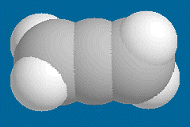 |
| Introduction |
| Symmetry Elements |
| · Proper Rotation Axis |
| · Mirror Plane |
| · Inversion Centre |
| · Improper Rotation Axis |
| · Identity |
| Point Group Gallery |
| Spotting a Chiral Compound |
| · Part I - Mirror Planes |
| · Part II - Inversion Centre |
| · Part III - Improper Rotation |
| · Summary & Conclusion |
| WSM Homepage |
Molecular Symmetry and Chirality
How to Spot a Chiral Compound
Note: viewing the structures on these pages requires use of
the MDL Chime Plug-In.
| Part II - Inversion Centre | [Part I] [Part III] [Summary] |
So, you mean mirror planes don't really tell you about chirality, either?
They do. But they only tell you half the story.
Lack of a mirror plane (σ) is a necessary condition for chirality, but not a sufficient one. In addition, a molecule must also lack a centre of inversion (i). In other words, presence of a mirror plane guarantees that a molecule is not chiral, but absence of the mirror plane does not (by itself) guarantee that it is chiral. Compounds belonging to the Ci point group illustrate this point: they have no mirror plane, but they do have a centre of inversion, which renders them achiral. An (admittedly somewhat esoteric) example is this isomer of the cyclopentadienylmethoxynitrosylchromium(I) dimer, [CpCr(NO)(OMe)]2.
The compound has no mirror plane, and so you might expect it to be a different molecule that its mirror image. However, it possesses a centre of inversion, because of which the complex is not chiral, and it is identical to its mirror image.
The compounds are mirror images, and they do not have a plane of symmetry. However, they are the same achiral molecule, not enantiomers.
So, how do we spot a chiral compound?.
• Rule One: A compound is chiral if it has four different bonds to carbon.
• Rule Two: Rule One sucks, because it only applies to organic compounds with a single stereocentre. Instead, a compound is chiral if it lacks a mirror plane.
• Rule Three: Rule Two is good, but not perfect. A compound is chiral if it lacks both σ and i. In rare cases, a compound will lack σ but possess i, and so lose its expected chirality.
Rule Two almost always works. Rule Three is even better, probably good 99.995% of the time. But strictly speaking, it's not true, either, as we see in Part III.
This page is maintained and copyright by W. Stephen McNeil at UBC Okanagan.
.